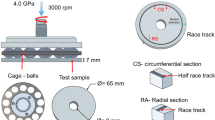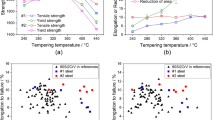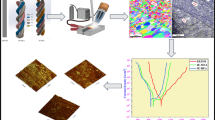Abstract
The fatigue crack growth rates,da/dN, and the fracture toughness, KIc have been measured in two high-carbon martensitic stainless steels, 440C and BG42. Variations in the retained austenite contents were achieved by using combinations of austenitizing temperatures, refrigeration cycles, and tempering temperatures. In nonrefrigerated 440C tempered at 150 °C, about 10 vol pct retained austenite was transformed to martensite at the fracture surfaces duringK Ic testing, and this strain-induced transformation contributed significantly to the fracture toughness. The strain-induced transformation was progressively less as the tempering temperature was raised to 450 °C, and at the secondary hardening peak, 500 °C, strain-induced transformation was not observed. In nonrefrigerated 440C austenitized at 1065 °C,K Ic had a peak value of 30 MPa m1/2 on tempering at 150 °C and a minimum of 18 MPa m1/2 on tempering at 500 °C. Refrigerated 440C retained about 5 pct austenite, and did not exhibit strain-induced transformation at the fracture surfaces for any tempering temperature. TheK Ic values for corresponding tempering temperatures up to the secondary peak in refrigerated steels were consistently lower than in nonrefrigerated steels. All of the BG42 specimens were refrigerated and double or quadruple tempered in the secondary hardening region; theK Ic values were 16 to 18 MPa m1/2 at the secondary peak. Tempered martensite embrittlement (TME) was observed in both refrigerated and nonrefrigerated 440C, and it was shown that austenite transformation does not play a role in the TME mechanism in this steel. Fatigue crack propagation rates in 440C in the power law regime were the same for refrigerated and nonrefrigerated steels and were relatively insensitive to tempering temperatures up to 500 °C. Above the secondary peak, however, the fatigue crack growth rates exhibited consistently lower values, and this was a consequence of the tempering of the martensite and the lower hardness. Nonrefrigerated steels showed slightly higher threshold values, ΔKth, and this was ascribed to the development of compressive residual stresses and increased surface roughening in steels which exhibit a strain-induced martensitic transformation.
Similar content being viewed by others
References
V. F. Zackay, E. R. Parker, D. Fahr, and R. Busch:Trans. ASM, 1967, vol. 60, pp. 252–59.
D. Webster:Metall. Trans., 1971, vol. 2, pp. 2097–2104.
S.D. Antolovich and B. Singh:Metall. Trans., 1971, vol. 2, pp. 2135–41.
W.W. Gerberich and J.P. Birat:Int. J. Fract. Mech., 1971, vol. 7, pp. 108–10.
G. Y. Lai:Materials Science and Engineering, 1975, vol. 19, pp. 153–56.
G. Y. Lai, W. E. Wood, R. A. Clark, V. F. Zackay, and E. R. Parker:Metall. Trans., WA, vol. 5, pp. 1663–70.
C. N. Sastry, K. H. Kahn, and W. E. Wood:Metall. Trans. A, 1982, vol. 13A, pp. 676–80.
A.G. Pineau and R.M. Pelloux:Metall. Trans., 1974, vol. 5, pp. 1103–12.
G. Thomas:Metall. Trans. A, 1978, vol. 9A, pp. 439–50.
R.A. Clark and G. Thomas:Metall. Trans. A, 1975, vol. 6A, pp. 969–79.
H.K.D.H. Bhadeshia and D.V. Edmonds:Metal Science, 1979, vol. 13, pp. 325–34.
R.M. Horn and R.O. Ritchie:Metall. Trans. A, 1978, vol. 9A, pp. 1039–53.
ASTM E-399-81,Standard Test Method for Plane-Strain Fracture Toughness of Metallic Materials, Amer. Soc. for Testing and Materials, Philadelphia, PA, 1981.
J. Durnin and K. A. RActal:J. Iron Steel Inst., 1968, vol. 206, pp. 60–67.
Chongmin Kim, A. Richard Johnson, and William F. Hosford:Metall. Trans. A, 1982, vol. 13A, pp. 1595–1605.
R.M. Horn:Metall. Trans. A, 1975, vol. 6A, pp. 1525–33.
R.O. Ritchie:Metal Science, 1977, vol. 11, pp. 368–81.
W. Elber:Eng. Fracture Mech., 1970, vol. 2, pp. 37–45.
W. Elber:The Significance of Fatigue Crack Closure, ASTM STP 486, American Society for Testing and Materials, Philadelphia, PA, 1971, p. 230.
A.T. Stewart:Eng. Fract. Mech., 1980, vol. 13, pp. 463–78.
S. Suresh, G. F Zamiski, and R. O. Ritchie:Metall. Trans. A, 1981, vol. 12A, pp. 1435–43.
R. O. Ritchie, S. Suresh, and C. M. Moss:J. Eng. Mat. Tech., Trans. ASME Series H, 1980, vol. 102, pp. 293–99.
N. Walker and C.J. Beevers:Fatigue Eng. Mat. Struct., 1979, vol. 1, pp. 1103–12.
K. Minakawa and A.J. McEvily:Scr. Metall., 1981, vol. 15, pp. 633–36.
R.O. Ritchie and S. Suresh:Metall. Trans. A, 1982, vol. 13A, pp. 937–40.
S. Suresh and R.O. Ritchie:Metall. Trans. A, 1982, vol. 13A, pp. 1627–31.
Author information
Authors and Affiliations
Rights and permissions
About this article
Cite this article
Lou, B., Averbach, B.L. The effects of heat treatment on fracture toughness and fatigue crack growth Rates in 440C and BG42 steels. Metall Trans A 14, 1899–1906 (1983). https://doi.org/10.1007/BF02645561
Received:
Issue Date:
DOI: https://doi.org/10.1007/BF02645561




